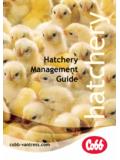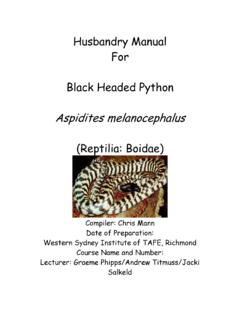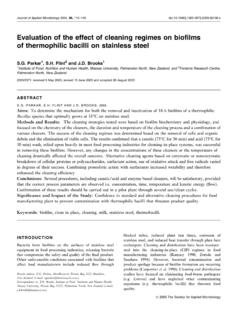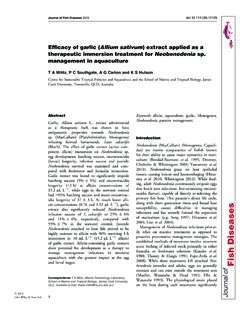Transcription of WESTERN SNOWY PLOVER NATURAL HISTORY …
1 1 WESTERN SNOWY PLOVER NATURAL HISTORY AND population trends Adapted from Fish and Wildlife WESTERN SNOWY PLOVER Pacific Coast population Draft Recovery Plan, May 2001 DESCRIPTION AND TAXONOMY The SNOWY PLOVER is a small, sparrow-sized shorebird in the family Charadriidae. It is pale gray-brown above and white below, with a white hind neck collar and dark lateral breast patches, forehead bar, and eye patches (see Figure 1). The bill and legs are blackish. Figure 1. Adult male SNOWY PLOVER (photo by Jack Haverty) In breeding plumage, males usually have black markings on the head and breast; in females, usually one or more of these markings are dark brown. Early in the breeding season, a rufous crown is evident on breeding males, but not on females. In nonbreeding plumage, sexes cannot be distinguished because the breeding markings disappear. Fledged juveniles have white edges on their wing coverts and scapulars and can thus be distinguished from adults until approximately July through October, depending on when the eggs hatch.
2 During this period, molt and feather wear makes fledged juveniles indistinguishable from adults. The mean annual life span of SNOWY plovers is about three years. The species was first described in 1758. Two subspecies of the SNOWY PLOVER have been recognized in North America: the WESTERN SNOWY PLOVER (Charadrius alexandrinus nivosus) and the Cuban SNOWY PLOVER (C. a. tenuirostris). The WESTERN SNOWY PLOVER breeds on the Pacific coast from southern Washington to southern Baja California, Mexico, and in interior areas of Oregon, California, Nevada, and several other WESTERN states. The Pacific coast population of WESTERN SNOWY PLOVER was listed by the federal government as threatened in 1993. This population of the SNOWY PLOVER is defined as those individuals that nest on the mainland coast, peninsulas, offshore islands, bays, estuaries, or rivers of the United States Pacific coast and Baja California, Mexico. 2 LIFE HISTORY AND ECOLOGY Breeding The Pacific coast population of the WESTERN SNOWY PLOVER breeds primarily on coastal beaches from southern Washington to southern Baja California, Mexico.
3 Sand spits, dune-backed beaches, beaches at creek and river mouths, and salt pans at lagoons and estuaries are the main coastal habitats for nesting. Less common nesting habitats include bluff-backed beaches, dredged material disposal sites, salt pond levees, dry salt ponds, and river bars. population Size and Distribution SNOWY plovers concentrate in suitable habitat, with the number of adults at coastal breeding locations ranging from 1 to 246, depending, in part, on the size of the area. It is estimated that, at most, about 2,000 SNOWY plovers may breed along the Pacific coast and at least a similar number breed on the west coast of Baja California. The largest number of breeding birds occurs from south San Francisco Bay to southern Baja California. Arrival and Courtship Nesting birds at coastal locations consist of both year-round residents and migrants. Migrants begin arriving at breeding sites in southern Washington in early March in central California as early as January, although the main arrival is from early March to late April.
4 Since some individuals nest at multiple locations during the same year, birds may continue arriving through June. Although pair bonds are first observed on the breeding grounds, they are likely to begin while birds are together in wintering flocks. Mated birds from the previous breeding season frequently reunite. Old and new pair bonds may be established prior to territory defense and nest scraping. In California, pre-nesting bonds and courtship activities are observed as early as mid-February. During courtship, males defend territories and usually make multiple scrapes. A scrape is a depression in the sand or substrate that a male constructs by leaning forward on his breast and scratching his feet while rotating his body. Females choose which scrape becomes the nest site by laying eggs in one of them. Duration of Breeding Season Earliest nests on the California coast occur during the first week of March in some years and by the third week of March in most years.
5 Peak nesting is from mid-April to mid-June. Hatching lasts from early April through mid-August, with chicks reaching fledging age approximately one month after hatching. Nests and Nest Sites Nests typically occur in flat, open areas with sandy or saline substrates; vegetation and driftwood are usually sparse or absent. Nests consist of a shallow scrape or depression lined with beach debris ( small pebbles, shell fragments, plant debris, and mud chips); nest lining increases as incubation progresses. Driftwood, kelp, and dune plants provide cover for chicks that crouch near objects to hide from predators. Invertebrates are often found near debris, so driftwood and kelp are also important for harboring PLOVER food sources. Although the majority of SNOWY plovers are site-faithful, returning to the same breeding site in subsequent breeding seasons, some also disperse within and between years. Birds occasionally nest in exactly the same location as the previous year.
6 3 Egg Laying, Clutch Size, and Incubation Initiation of clutches and egg laying occurs from early March through the third week of July. The approximate periods required for nesting events are: Scrape construction (and courtship and mating) - 3 days to more than a month; Egg laying usually 4 to 5 days; Incubation 26 to 31 days (mean 27 days) The usual clutch size is three eggs (see Figure 2) but two to four eggs are not unusual. Both sexes incubate the eggs, with the female tending to incubate during the day and the male at night. Figure 2. SNOWY PLOVER clutch (photo by Jack Haverty) Adult plovers will frequently attempt to lure people and predators from hatching eggs with alarm calls and distraction displays. Occasionally, parents behave similarly when they have incomplete clutches or, less often, clutches that are only partly incubated. More typical, however, is for the incubating adult to run away from the eggs without being seen.
7 SNOWY plovers renest readily after loss of their eggs. Renesting occurs 2 to 14 days after failure of a clutch and up to five renesting attempts have been observed for a pair. Double brooding with polyandry (meaning the female successfully hatches more than one brood in a nesting season with different mates) is common. Some females triple brood and some males to double brood. After losing a clutch or brood ( a group of chicks) or successfully hatching a nest, plovers may renest at the same site or move up to a few hundred miles to nest at other sites. Clutch Hatching Success Clutch hatching success (percent of clutches hatching at least one egg) varies widely depending upon site conditions. Low clutch hatching success can be attributed to variety of causes such as predation, human disturbance, high tides, and inclement weather. 4 Brood-rearing The first chick hatched remains in or near the nest until other eggs (or at least the second egg) hatch.
8 The adult PLOVER , while incubating the eggs, also broods the first chick. The nonincubating adult may also brood the first-born chick a short distance from the nest. If the third egg of a clutch is 24 to 48 hours behind the others in hatching, it may be deserted. SNOWY PLOVER chicks (see Figure 3) are precocial, leaving the nest within hours after hatching to search for food. They are not able to fly for approximately 4 weeks after hatching; fledging requires 28 to 33 days. Broods rarely remain in the nesting area until fledging. PLOVER broods may travel along the beach as far as kilometers (4 miles) from their natal area. Adult plovers do not feed their chicks, but lead them to suitable feeding areas. Adults use distraction displays to lure predators and people away from chicks. Adult plovers signal the chicks to crouch, with calls, as another way to protect them. They may lead chicks, especially larger ones, away from predators.
9 Most chick mortality occurs within 6 days after hatching. Females generally desert mates and broods by the sixth day after hatching and thereafter the chicks are typically accompanied only by the male. While males rear broods, females obtain new mates and initiate new nests. Figure 5. SNOWY PLOVER chick (photo by Jack Haverty) Fledging Success The fledging success of SNOWY plovers (percentage of hatched young that reach flying age) varies greatly by location and year. Even SNOWY plovers nesting on neighboring beach segments may exhibit quite different success in the same year. Chicks are considered fledged at 28 days after hatching. Feeding Habitat and Habits 5 SNOWY plovers are primarily visual foragers, using the run-stop-peck method of feeding. They forage on invertebrates in the wet sand and amongst surf-cast kelp within the intertidal zone, in dry, sandy areas above the high tide, on salt pans, on spoil sites, and along the edges of salt marshes, salt ponds, and lagoons.
10 They sometimes probe for prey in the sand and pick insects from low-growing plants. Migration While some SNOWY plovers remain in their coastal breeding areas year-round, others migrate south or north for winter. Some studies in Monterey Bay showed 41 percent of nesting males and 25 percent of nesting females were consistent year-round residents. The migrants vacate California nesting areas primarily from late June to late October. Most plovers that nest inland migrate to the coast for the winter. Those from the Central Valley of California and the WESTERN Great Basin migrate to the California or Baja California coasts, and those from the eastern Great Basin (Great Salt Lake) migrate to Mexico. The departure from inland nesting areas begins by early July and is completed, except for stragglers, by mid-October. Thus, the flocks of nonbreeding birds that begin forming along the Pacific coast in early July are a mixture of adult and hatching-year birds from both coastal and interior nesting areas.







